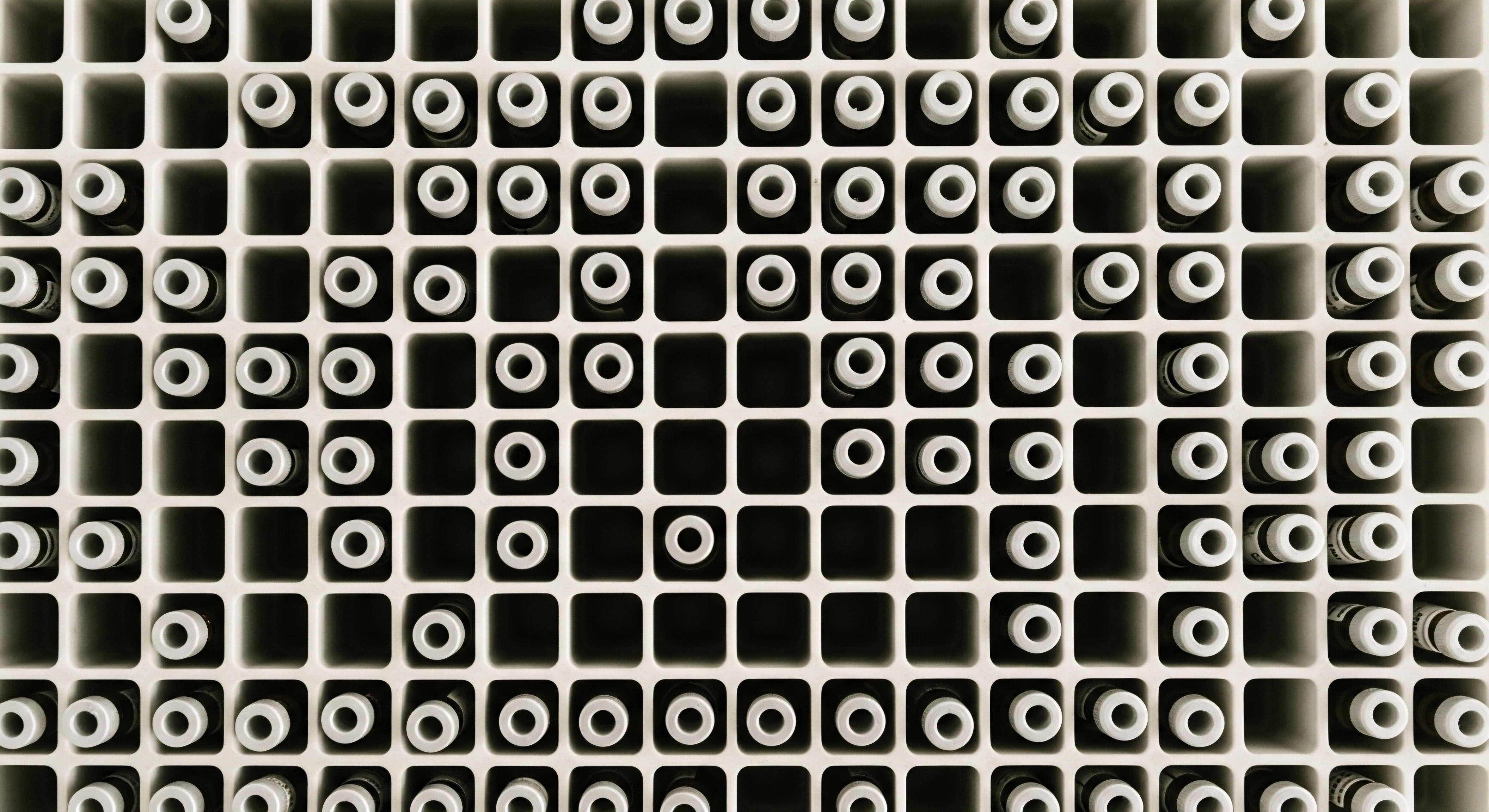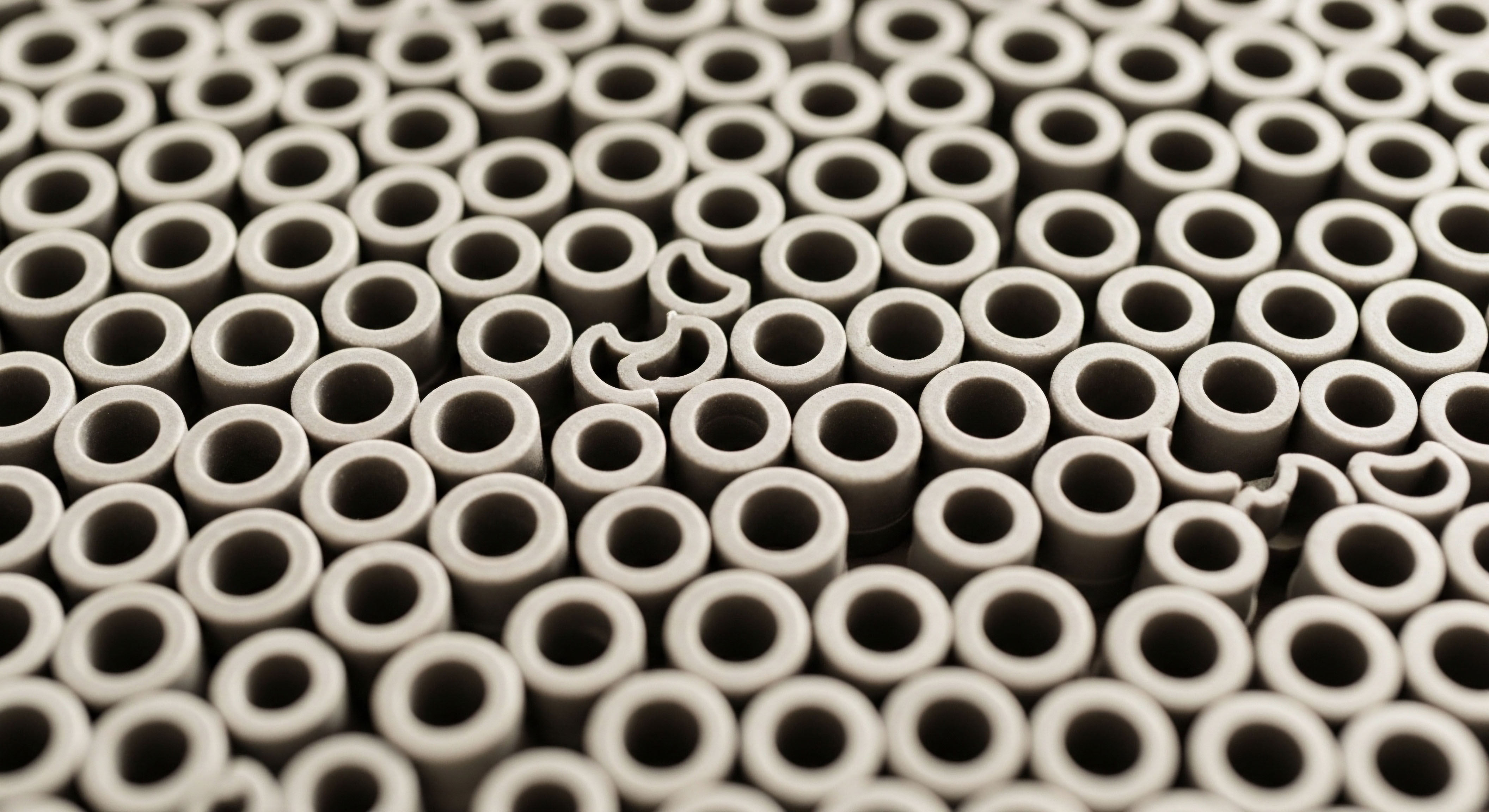

Fundamentals
You feel it before you can name it. A subtle shift in energy, a change in how your body responds to exercise, or a new fogginess in your thoughts. These experiences are not imagined; they are the physical manifestations of a complex and elegant internal communication network undergoing a significant transition.
The question of whether lifestyle alone can reverse these age-related metabolic and hormonal declines is a deeply personal one, rooted in the desire to reclaim a sense of vitality that seems to be slipping away. The answer begins with understanding that your body is a system of interconnected signals, a biological conversation that has been happening every moment of your life. Age does not silence this conversation, but it can change its tone and rhythm.
The gradual and progressive age-related decline in hormone production has a tangible impact on human health, increasing the risk for chronic disease and influencing life span. This is not a simple story of one hormone diminishing, but a cascade of changes across multiple systems.
For instance, as we age, there’s a natural tendency to lose muscle mass and gain body fat, a process that directly affects our metabolic health. This shift in body composition is intricately linked to how our bodies use energy and respond to insulin, the master regulator of blood sugar.
When insulin sensitivity decreases, a common occurrence with age, it sets the stage for a host of metabolic challenges. The fatigue, the difficulty in maintaining a healthy weight, the changes in mood ∞ these are all downstream effects of a system that is recalibrating.
The gradual decline in hormone production and action with age has a detrimental impact on human health by increasing the risk for chronic diseases.
The journey to addressing these changes starts with acknowledging the profound intelligence of your own biology. Lifestyle interventions ∞ specifically, targeted nutrition and consistent physical activity ∞ are powerful tools because they speak the body’s native language. They are not merely about calories in and calories out; they are about providing the precise inputs your cells need to function optimally.
Resistance training, for example, does more than build muscle; it sends a powerful signal to your body to produce growth hormone and improve insulin sensitivity. A diet rich in nutrient-dense foods provides the building blocks for hormone production and reduces the chronic inflammation that can disrupt these delicate signaling pathways. These are not superficial fixes; they are foundational strategies that can influence the core processes of aging.
The endocrine system, the network of glands that produces hormones, is a dynamic and responsive system. It is constantly adapting to the demands of your environment and your internal state. While the aging process introduces certain predictable changes, the system’s capacity for adaptation remains.
Lifestyle choices are the most direct way to influence this adaptive capacity. They can create an internal environment that supports robust hormonal communication and efficient metabolic function. This is the basis for the reversal of many age-related declines. The process is not about turning back the clock in a literal sense, but about optimizing the function of your biological systems at your current age, allowing you to live with greater vitality and resilience.


Intermediate
To truly grasp the potential of lifestyle interventions, we must move beyond general wellness advice and into the specific mechanisms by which these strategies influence hormonal and metabolic health. The conversation shifts from “eat well and exercise” to a more precise understanding of how these actions directly impact the complex feedback loops that govern your endocrine system.
The question is not just whether lifestyle can help, but how it exerts its influence on a cellular and systemic level. This deeper understanding empowers you to make choices that are not just healthy in a general sense, but strategically targeted to your unique physiology.
The hypothalamic-pituitary-gonadal (HPG) axis is a prime example of a critical feedback loop that changes with age. This axis represents a continuous conversation between your brain (hypothalamus and pituitary) and your gonads (testes or ovaries). In men, this system regulates testosterone production, while in women, it governs the menstrual cycle and the production of estrogen and progesterone.
With age, the sensitivity of this axis can change, leading to a gradual decline in sex hormone production. Lifestyle interventions can directly influence this axis. For example, chronic stress and poor sleep can dysregulate the HPG axis, while targeted exercise and a nutrient-dense diet can support its function.
Lifestyle modifications such as regular exercise and a healthy diet can favorably affect endocrine and metabolic functions, acting as countermeasures to various age-related diseases.

Targeted Protocols for Hormonal Optimization
When lifestyle interventions alone are insufficient to restore optimal function, clinically supervised hormonal optimization protocols may be considered. These are not a one-size-fits-all solution but are tailored to the individual’s specific needs, as determined by comprehensive lab testing and a thorough evaluation of symptoms.

Testosterone Replacement Therapy (TRT) for Men
For men experiencing the symptoms of low testosterone, such as fatigue, decreased muscle mass, and low libido, TRT can be a transformative intervention. A standard protocol often involves weekly intramuscular injections of Testosterone Cypionate. This is frequently combined with other medications to ensure a balanced and safe approach:
- Gonadorelin ∞ This medication is used to maintain the natural production of testosterone by stimulating the pituitary gland. This helps to preserve testicular function and fertility.
- Anastrozole ∞ Anastrozole is an aromatase inhibitor, which means it blocks the conversion of testosterone to estrogen. This helps to prevent potential side effects associated with elevated estrogen levels.
- Enclomiphene ∞ This may be included to support the production of luteinizing hormone (LH) and follicle-stimulating hormone (FSH), further supporting the body’s natural testosterone production.

Hormonal Support for Women
For women in perimenopause or post-menopause, hormonal support can alleviate a wide range of symptoms, from hot flashes and mood swings to low libido and vaginal dryness. Protocols are highly individualized and may include:
- Low-Dose Testosterone ∞ Women produce and require testosterone, though in much smaller amounts than men. Low-dose testosterone therapy, often administered via subcutaneous injection (e.g. 10-20 units weekly), can significantly improve energy, mood, and libido.
- Progesterone ∞ Progesterone is often prescribed, particularly for women who still have a uterus, to protect the uterine lining and provide a sense of calm.
- Estrogen Therapy ∞ For women experiencing significant vasomotor symptoms (hot flashes and night sweats), estrogen therapy remains the most effective treatment.

The Role of Peptide Therapies
Peptide therapies represent a more targeted approach to stimulating the body’s own production of growth hormone (GH). As we age, GH levels naturally decline, contributing to changes in body composition, energy levels, and recovery. Peptides like Sermorelin, Ipamorelin, and CJC-1295 work by stimulating the pituitary gland to release more GH in a natural, pulsatile manner.
These therapies can lead to a range of benefits, including:
- Increased lean muscle mass
- Reduced body fat
- Improved sleep quality
- Enhanced recovery from exercise and injury
- Improved skin elasticity and bone density
Peptide therapy is often used by active adults and athletes seeking to optimize performance and combat the effects of aging. It is considered a safer alternative to direct HGH administration because it works with the body’s own regulatory systems.
| Peptide | Primary Mechanism | Common Benefits |
|---|---|---|
| Sermorelin | Stimulates the pituitary gland to release GH | Improved sleep, increased energy, enhanced recovery |
| Ipamorelin/CJC-1295 | A synergistic combination that amplifies GH release | Increased muscle mass, reduced body fat, improved skin tone |
| Tesamorelin | A GHRH analog with a strong effect on visceral fat | Significant reduction in abdominal fat, improved metabolic markers |
For those seeking to address specific concerns, other targeted peptides are available. PT-141, for instance, is a peptide that works on the nervous system to improve sexual arousal and desire in both men and women. Pentadeca Arginate (PDA) is another peptide that shows promise in tissue repair and reducing inflammation.
| Peptide | Primary Application | Mechanism of Action |
|---|---|---|
| PT-141 | Sexual Health | Activates melanocortin receptors in the brain to increase libido |
| Pentadeca Arginate (PDA) | Tissue Repair | Promotes healing and reduces inflammation |
Ultimately, the decision to pursue lifestyle interventions, hormonal optimization, or peptide therapies should be made in consultation with a knowledgeable healthcare provider. A personalized approach, guided by data and a deep understanding of your individual biology, offers the greatest potential for reclaiming vitality and function.


Academic
A systems-biology perspective reveals that age-related hormonal and metabolic decline is not a linear failure of isolated components but a dynamic shift in the intricate network of signaling pathways that maintain homeostasis. The question of reversal through lifestyle interventions alone requires a nuanced analysis of the underlying molecular mechanisms and the threshold at which physiological changes become less responsive to non-pharmacological stimuli.
The endocrine system’s response to aging is characterized by altered secretory patterns, changes in receptor sensitivity, and a recalibration of feedback loops, particularly within the hypothalamic-pituitary-gonadal (HPG) and hypothalamic-pituitary-adrenal (HPA) axes.
The concept of “inflammaging,” or chronic, low-grade inflammation, is a central driver of this decline. This persistent inflammatory state can disrupt hormonal signaling and contribute to insulin resistance, a key feature of metabolic aging. Lifestyle interventions, particularly those that modulate the gut microbiome and reduce oxidative stress, can directly target the sources of inflammaging.
For example, a diet rich in polyphenols and fiber can alter the composition of the gut microbiota, leading to the production of short-chain fatty acids (SCFAs) like butyrate, which have potent anti-inflammatory effects. Exercise, in turn, has been shown to reduce visceral adipose tissue, a primary source of inflammatory cytokines.
Age-related changes in the neuroendocrine system have significant consequences for overall health and contribute to the development of various age-related diseases.

Can Lifestyle Interventions Fully Restore Hormonal Axes?
While lifestyle interventions can significantly improve the function of hormonal axes, the extent to which they can “reverse” age-related decline is a matter of degree. In the early stages of hormonal changes, such as perimenopause or the initial decline in testosterone, lifestyle modifications can have a profound impact.
By reducing the allostatic load on the system ∞ the cumulative cost of chronic stress and dysregulation ∞ these interventions can restore a more youthful hormonal milieu. However, once a certain threshold of glandular exhaustion or receptor desensitization is crossed, lifestyle interventions alone may be insufficient to restore physiological levels of hormones.
Consider the somatopause, the age-related decline in growth hormone (GH) secretion. While exercise and improved sleep can boost GH production, they are unlikely to restore GH levels to those of a 20-year-old. This is where interventions like growth hormone-releasing hormone (GHRH) analogs, such as Sermorelin or CJC-1295, come into play.
These peptides work by stimulating the pituitary gland’s endogenous capacity to produce GH, representing a more physiological approach than direct GH administration. The combination of lifestyle optimization and targeted peptide therapy can create a synergistic effect, amplifying the body’s natural regenerative capacity.

The Interplay of Metabolic Health and Hormonal Function
The relationship between metabolic health and hormonal function is bidirectional. Insulin resistance not only contributes to metabolic syndrome but also disrupts hormonal balance. For example, in women, high insulin levels can stimulate the ovaries to produce more testosterone, contributing to symptoms of androgen excess. In men, insulin resistance is associated with lower testosterone levels. Therefore, any intervention that improves insulin sensitivity will have a positive cascading effect on the endocrine system.
Lifestyle interventions that target insulin sensitivity, such as a low-glycemic diet, intermittent fasting, and regular exercise, are foundational to any hormonal optimization strategy. These interventions can improve the cellular response to insulin, reducing the need for the pancreas to produce excessive amounts of this hormone.
This, in turn, can help to rebalance the HPG axis and improve sex hormone profiles. When these interventions are combined with targeted hormonal support, such as TRT for men or bioidentical hormone replacement for women, the results can be a significant restoration of both metabolic and endocrine function.
The decision to incorporate pharmacological interventions should be based on a comprehensive assessment of an individual’s biology, including genetic predispositions, epigenetic modifications, and current biomarker status. A systems-based approach recognizes that there is no single “magic bullet” for reversing age-related decline. Instead, it involves a multi-pronged strategy that combines foundational lifestyle interventions with targeted, clinically-supervised protocols to create a personalized roadmap to optimal health and longevity.

References
- Veldhuis, Johannes D. et al. “Hormonal and Metabolic Changes of Aging and the Influence of Lifestyle Modifications.” Mayo Clinic Proceedings, vol. 95, no. 8, 2020, pp. 1765-1789.
- Santanasto, Adam J. et al. “Metabolic changes in aging humans ∞ current evidence and therapeutic strategies.” The Journal of Clinical Investigation, vol. 132, no. 16, 2022.
- Lerwill, Christian. “14 Tips to Reverse Aging & Improve Your Biological Age.” OrthoCarolina, 2023.
- “How to Reverse Aging Naturally & Improve Your Biological Age.” InsideTracker, 2024.
- Bassil, N. et al. “The benefits and risks of testosterone replacement therapy ∞ a review.” Therapeutics and Clinical Risk Management, vol. 5, 2009, pp. 427-448.
- “What is the lowest dose of testosterone for a 46-year-old perimenopausal woman to inject?” Research, 2025.
- “Should we be prescribing testosterone to perimenopausal and menopausal women? A guide to prescribing testosterone for women in primary care.” Post Reproductive Health, vol. 26, no. 2, 2020, pp. 69-74.
- “Hypothalamic ∞ pituitary ∞ gonadal axis.” Wikipedia, 2024.
- “Anti-Aging Peptide Therapy ∞ The Top 12 Questions Answered.” Rejuvenated Medical Spa, 2022.
- “Sermorelin vs. CJC-1295 vs. Ipamorelin ∞ Comparing Popular Growth Hormone Peptides.” Peptides.org, 2024.
- Gulati, Mahima. “Lifestyle Medicine’s Role in Common Hormonal Disorders ∞ A Case-Based Discussion.” American Journal of Lifestyle Medicine, vol. 18, no. 5, 2024, pp. 638-647.
- “Treatment of Symptoms of the Menopause ∞ An Endocrine Society Clinical Practice Guideline.” The Journal of Clinical Endocrinology & Metabolism, vol. 100, no. 11, 2015, pp. 3975-4011.
- “Hormones and Aging ∞ An Endocrine Society Scientific Statement.” The Journal of Clinical Endocrinology & Metabolism, vol. 108, no. 7, 2023, pp. 1623-1652.
- “Systems Biology of Aging Lab – Current Research.” Google Sites, 2024.
- “Libido Improvement Through Peptide Therapy ∞ PT 141 ‘The Sex Peptide’.” The Center for Natural & Integrative Medicine, 2022.

Reflection
The information presented here is a map, not the territory itself. Your lived experience, the unique landscape of your body, is the true ground upon which your health journey unfolds. The science of hormonal and metabolic health provides a powerful framework for understanding the changes you may be experiencing, but it is the application of this knowledge to your own life that creates meaningful transformation.
The path forward is one of partnership ∞ with your own body and with a clinical guide who can help you interpret its signals.
Consider the information you have absorbed not as a set of rules to be followed, but as a set of tools to be used. The power lies in the consistent, intentional application of these tools over time. Each meal, each workout, each night of restful sleep is an opportunity to send a signal of vitality to your cells.
This is a process of recalibration, of gently guiding your biological systems back toward a state of balance and resilience. It is a journey of self-discovery, of learning the unique language of your own body and responding with wisdom and care.
The ultimate goal is not to chase an idealized version of youth, but to cultivate a state of optimal function at every stage of life. It is about having the energy to engage with the world, the mental clarity to pursue your passions, and the physical capacity to live without limitation.
This is the promise of a personalized, systems-based approach to health. The journey begins with the understanding that you are not a passive recipient of the aging process, but an active participant in the creation of your own well-being.

Glossary

age-related decline

hormone production

metabolic health

muscle mass

insulin sensitivity

lifestyle interventions

growth hormone

hpg axis

lifestyle interventions alone

hormonal optimization

perimenopause

peptide therapies

ipamorelin

peptide therapy

pt-141

insulin resistance

sermorelin




